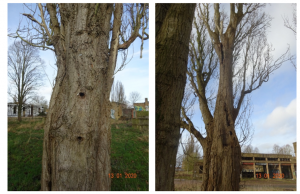Surveying trees for bat roost potential
When trees may need to be removed or worked on, their potential to be a home to bats has to be considered.
The first step in evaluating a tree for bats is assessing the number and quality of features where bats could potentially roost in the tree. Good bat roost features can include woodpecker holes, hollow stems and cracked branches to name just a few.
Wild Frontier Ecology undertook potential bat roost surveys for 300 individual trees and 23 groups of trees growing at a former RAF base in Cambridgeshire where a development was proposed. Trees were rated as having either low, medium or high potential for roosting bats.

This Lombardy poplar has high bat roost potential. (Left: multiple cavities in the stem. Right: decay and crevices in the stem)
This information was provided to the developer along with a full arboricultural assessment assessing the quality of the trees for planning purposes. Generally, it was those trees which had poorer arboricultural value and limited future life expectancy that had higher bat roost potential. Wild Frontier’s combined specialisms in ecology and arboriculture helped to provide the developer with advice on which trees were suitable for retention and which could be removed.
Future work on the site will include bat emergence surveys for those trees which are both targeted for removal and have potential for roosting bats. A subsequent application to Natural England for a European Protection Species licence can then be made to cover the required tree felling works and secure mitigation.
